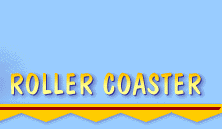|
Roller Coaster
 For many people, there is only one reason to go to an amusement
park: the roller coaster. Some people call it the "scream machine,"
with good reason. The history of this ride reflects a constant
search for greater and more death-defying thrills. For many people, there is only one reason to go to an amusement
park: the roller coaster. Some people call it the "scream machine,"
with good reason. The history of this ride reflects a constant
search for greater and more death-defying thrills.
How does a roller coaster
work?
What you may not realize as you're cruising down the track at
60 miles an hour is that the coaster has no engine. The car is
pulled to the top of the first hill at the beginning of the ride,
but after that the coaster must complete the ride on its own.
You aren't being propelled around the track by a motor or pulled
by a hitch. The conversion of potential energy to kinetic energy
is what drives the roller coaster, and all of the kinetic energy
you need for the ride is present once the coaster descends the
first hill..

Once you're underway, different types of wheels help keep the
ride smooth. Running wheels guide the coaster on the track. Friction
wheels control lateral motion (movement to either side of the
track). A final set of wheels keeps the coaster on the track even
if it's inverted. Compressed air brakes stop the car as the ride
ends.
Wooden or steel coaster: Does
it make a difference?
Roller coasters can be wooden or steel, and can be looping or
nonlooping. You'll notice a big difference in the ride depending
on the type of material used. In general, wooden coasters are
nonlooping. They're also not as tall and not as fast, and they
don't feature very steep hills or as long a track as steel ones
do. Wooden coasters do offer one advantage over steel coasters,
assuming you're looking for palm-sweating thrills: they sway a
lot more. Tubular steel coasters allow more looping, higher and
steeper hills, greater drops and rolls, and faster speeds.
How did coasters come to be?
Read more about their history.
|


